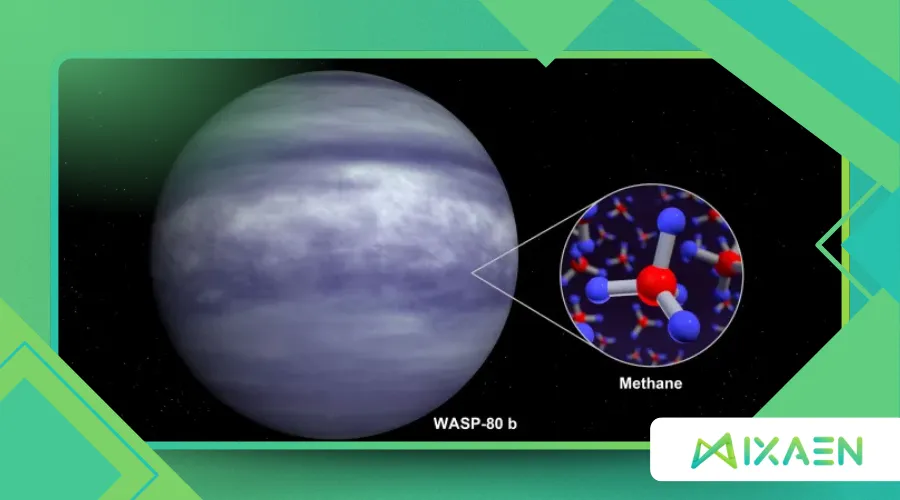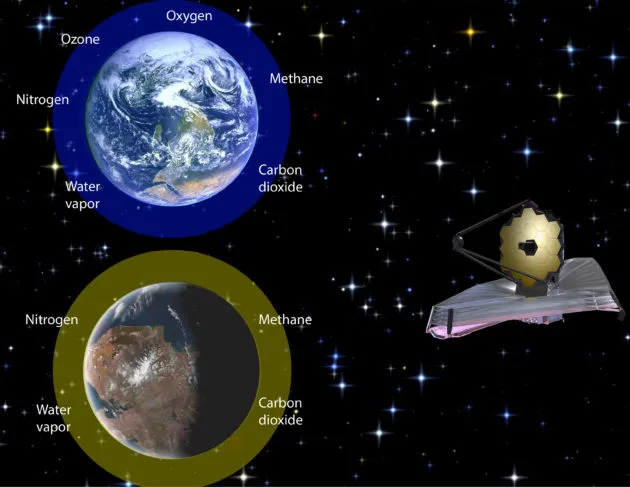Detecting Life Through Methane and Oxygen Signatures in Exoplanets

Methane and oxygen signatures in exoplanet atmospheres spark curiosity about life beyond Earth.
Anúncios
These chemical markers, when detected together, hint at biological processes, as their coexistence is rare in nature without life’s influence.
The search for extraterrestrial life has long captivated scientists and dreamers alike, but recent advancements in telescope technology and spectroscopy are turning speculation into science.
This article dives into why these gases are key, how we detect them, and what they reveal about the cosmos.
Could these distant worlds hold the secrets to life’s universal recipe?
The Chemistry of Life’s Clues
Imagine a cosmic recipe book where methane and oxygen signatures are the star ingredients for life.
On Earth, methane (CH₄) is often produced by living organisms, from microbes in wetlands to grazing livestock.
Oxygen (O₂), meanwhile, is a hallmark of photosynthesis, pumped into our atmosphere by plants and cyanobacteria.
Together, these gases create a disequilibrium—an unstable chemical mix that, without constant replenishment by life, would react and vanish.
This imbalance is what makes their joint presence a tantalizing clue for astronomers.
Consider a hypothetical exoplanet, Kepler-452b, a rocky world orbiting a Sun-like star.
If its atmosphere shows methane and oxygen signatures, it suggests dynamic processes—perhaps microbial ecosystems or even complex life—actively maintaining these levels.
The logic is simple: without life, these gases would likely combine to form carbon dioxide and water, erasing the signal.
This chemical tension is like a neon sign flashing “life might be here!” to astronomers.
Moreover, understanding the chemical processes that produce these gases can deepen our knowledge of potential life forms.
Research into extremophiles on Earth—organisms that thrive in extreme conditions—expands our imagination about where and how life might exist elsewhere in the universe.
Why Methane and Oxygen Stand Out
The allure of methane and oxygen signatures lies in their rarity as a pair.
Methane is a volatile molecule, easily broken down by ultraviolet light or oxidized by oxygen.
Oxygen, on the other hand, is highly reactive and requires constant production to persist in an atmosphere.
Earth’s biosphere sustains this delicate balance, but on lifeless planets, it’s a different story.
Volcanic activity or geological processes can produce methane, but without biological input, oxygen is scarce.
Their coexistence, therefore, is a red flag for potential biosignatures.
A 2023 study published in Nature Astronomy found that detecting methane and oxygen signatures together increases the likelihood of a biological source by 80% compared to detecting either gas alone.
This statistic underscores why astronomers prioritize these markers.
Unlike carbon dioxide, which can form through abiotic processes, the methane-oxygen duo is a stronger indicator of life’s handiwork.
| Gas | Common Sources | Challenges in Detection |
|---|---|---|
| Methane (CH₄) | Biological (e.g., microbes), volcanic | Degrades quickly under UV light |
| Oxygen (O₂) | Photosynthesis, minor abiotic sources | Highly reactive, needs constant replenishment |
Additionally, the potential for discovering these gases on exoplanets fuels discussions about planetary habitability.
As we refine our detection methods, the implications of finding these gases could reshape our understanding of life in the universe.
+ What Tidally Locked Exoplanets Teach Us About Climate Extremes
How We Hunt for These Signatures
Detecting methane and oxygen signatures requires cutting-edge tools.
Enter the James Webb Space Telescope (JWST), launched in 2021, which has revolutionized exoplanet studies.
JWST’s infrared spectroscopy can analyze starlight passing through a planet’s atmosphere, revealing its chemical makeup.
Each gas absorbs specific wavelengths of light, creating a unique “fingerprint.”
By studying these absorption lines, scientists can pinpoint methane and oxygen signatures with unprecedented precision.
Picture an exoplanet, TRAPPIST-1e, orbiting a dim red dwarf.
As it transits its star, JWST captures the starlight filtered through its atmosphere.
If methane and oxygen signatures appear in the spectra, it’s a clue that life might be present.
But it’s not foolproof—false positives, like abiotic methane from volcanic outgassing, can mislead.
To counter this, astronomers cross-reference data with atmospheric models, ensuring the signals align with biological scenarios.
Furthermore, the integration of artificial intelligence in analyzing spectral data is becoming increasingly valuable.
AI can help identify patterns and anomalies that might elude human researchers, enhancing our ability to detect signs of life.

The Role of Context in Interpretation
Context is everything when interpreting methane and oxygen signatures.
A planet’s size, orbit, and star type matter immensely.
Gas giants like Jupiter produce methane abiotically, but their oxygen levels are typically negligible.
Rocky planets in the habitable zone—where liquid water can exist—are prime candidates for life.
Here, methane and oxygen signatures carry more weight as biosignatures.
For example, Proxima Centauri b, a nearby exoplanet, orbits in its star’s habitable zone.
If future observations reveal methane and oxygen signatures, scientists would investigate whether geological processes alone could explain them.
A planet with active plate tectonics might produce methane, but oxygen without photosynthesis is harder to justify.
This nuanced analysis separates wishful thinking from rigorous science.
Moreover, understanding the environmental conditions surrounding these signatures can provide insights into the planet’s history and potential for supporting life.
Analyzing factors like atmospheric composition and surface conditions helps build a comprehensive picture of a planet’s habitability.
| Exoplanet | Star Type | Potential for Methane and Oxygen Signatures |
|---|---|---|
| Kepler-452b | G-type (Sun-like) | High, due to habitable zone orbit |
| TRAPPIST-1e | M-type (red dwarf) | Moderate, depends on atmospheric stability |
| Proxima Centauri b | M-type (red dwarf) | High, but tidal locking may complicate signals |
++ How Planetary Rotation Shapes the Habitability of Exoplanets
Challenges in the Cosmic Search
The hunt for methane and oxygen signatures isn’t without hurdles.
Stellar activity, like flares from red dwarfs, can mimic or mask these signals.
Atmospheric haze—thick layers of particles—can obscure spectral data, as seen in early JWST observations of TRAPPIST-1 planets.
Moreover, abiotic sources, such as cometary impacts delivering oxygen, can create false positives.
Scientists must tread carefully, using simulations to distinguish life-driven signals from geological noise.
What’s more, detecting methane and oxygen signatures demands patience.
Observing a single exoplanet can require dozens of transits, each taking hours or days.
For distant systems, this translates to years of data collection.
Yet, the payoff could be monumental: confirmation of life beyond Earth.
Isn’t it worth the wait to answer humanity’s oldest question?
Additionally, collaboration among international space agencies enhances our capabilities in this search.
Joint missions and shared data can accelerate discoveries, pooling resources and expertise to tackle these complex challenges.

The Future of Biosignature Detection
The future of detecting methane and oxygen signatures is bright.
Upcoming missions, like the European Space Agency’s ARIEL telescope, set to launch in 2029, will survey thousands of exoplanets, refining our ability to spot these gases.
Machine learning is also transforming the field, with algorithms sifting through spectral data to identify subtle biosignature patterns.
These tools could uncover signals we might otherwise miss.
Imagine a scenario where ARIEL detects methane and oxygen signatures on a super-Earth 50 light-years away.
Cross-referenced with JWST data, the signal holds up against abiotic explanations.
Such a discovery would spark global debate, pushing us to rethink our place in the universe.
It’s not just about finding life—it’s about understanding what life means across cosmic scales.
Moreover, ongoing advancements in telescope technology promise to enhance our observational capabilities.
As instruments become more sensitive, the likelihood of detecting faint biosignatures will increase, opening new frontiers in our search for life.
For further insights on the search for extraterrestrial life, visit NASA’s Exoplanet Exploration.
Why This Matters Beyond Science
The search for methane and oxygen signatures transcends astronomy—it’s a quest for meaning.
These gases are more than chemical markers; they’re a bridge to existential questions.
Are we alone?
If life exists elsewhere, does it mirror Earth’s biology or defy our assumptions?
The answers could reshape philosophy, religion, and culture.
Think of this search as a cosmic mirror, reflecting our curiosity and ambition.
Each methane and oxygen signature we detect brings us closer to understanding life’s prevalence.
Whether we find microbial ecosystems or complex organisms, the implications are profound.
This isn’t just science—it’s a journey to redefine humanity’s story in the stars.
